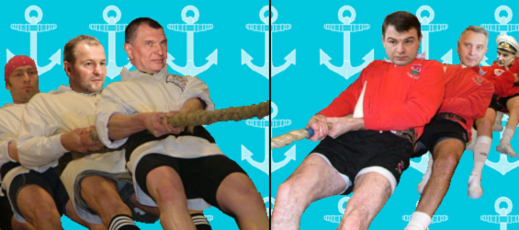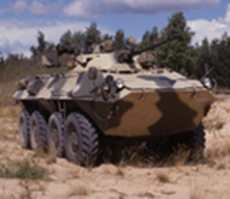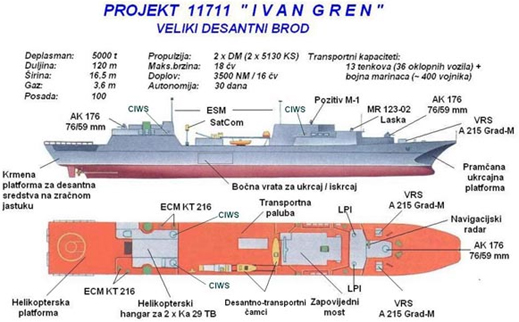
By John Helmer in Moscow
In the history of Russia it has never happened before that the oligarchs would take on the military establishment in a tug of war over billion-dollar assets.
This couldn’t have happened in the past, because asset power and military strength were the same thing — boyars were warlords. Or else the Communist Party commissars kept officers and troops on a very short leash, and Stalin shot those he didn’t like. Russia has come a way since then.
| Some oligarchs own factories that turn out military goods; Oleg Deripaska’s holding Basic Element, for example, owns three factories producing armoured cars. The Defense Ministry and the Army are less than happy with their quality, and have proposed buying German-made vehicles instead. “We, of course, won’t buy Russian vehicles and armored equipment in the condition they are in,” Anatoly Serdyukov, the Defence Minister, recently said. |  |
Occasionally, there have been fights between military industries and oligarch suppliers of raw materials. Usually slugged out behind closed doors, many of them have ended with the civilian assets taken over by Sergei Chemezov, an oligarch in his own right, whose state-financed conglomerate, Russian Technologies (formerly Rosoboronexport), owns titanium mines and refining plants, specialty steelmills, automotive plants, etc. Chemezov’s entrepreneurial idea has been to ‘protect’ the defence industries from price and profit-gouging proprietors by taking over and vertically integrating their sources of raw materials. He’d still be doing that if the crash of 2008 hadn’t wiped out his sources of state money, and President Dmitry Medvedev turned him into a public punching-bag, before trying to sell the conglomerate’s assets to Medvedev’s retainers.
Deripaska ran into military opposition in 2004 when he thought he could sell his aluminium rolling mills at Samara and Rostov to the Alcoa company of the US. That conflict was resolved by Dmitry Afanasiev, the lawyer Deripaska sent to advise the Russian government on how to buy the defence establishment’s accommodation. The security forces gave up their resistance but got their payoff; Deripaska got his deal; and Alcoa got the two factories for about $240 million at the start of 2005, though there have been rumblings from the military consumers of aluminium ever since.
The new affair is worth much more to everyone – about €2 billion. That’s a lot of retirement sunshine for the commissionaires. But for the time being, the tale is a brief one, because it has just got under way. Its significance for the future of Prime Minister Vladimir Putin (and maybe Medvedev) shouldn’t be underestimated.
| For Sechin, it’s a new episode in the protracted battle to take control of valuable Russian shipyard property and seaside real estate away from the Defence Ministry and Russian Navy, wherever it can be found – along the Pacific shoreline in the Russian Fareast, on the Barents and White Seas, on the Baltic at Kaliningrad, and at St. Petersburg. Converting state control of state-funded shipyards into privately owned, state-funded shipyards can be more lucrative than running a casino. That idea had occurred to former presidential candidate, Putin protégé, and Deputy Prime Minister Sergei Ivanov. For a time, Ivanov was in charge of both the military and the civilian shipping sector. But he disappeared through the floor when Medvedev was chosen to be president. The only paying posts and sinecures Ivanov has been able to hang on to have been too cheap for Sechin to want. |  |
The lure of the sea – I mean, money beside the sea – is irresistible. At least, that’s what Vladimir Potanin, Alexander Nesis and Sergei Pugachev have supposed, when each of them they tried owning the Northern and Baltic Plant shipyards in St. Petersburg, so that they could convert trillions of roubles in budget allocations for warships into personal takings for themselves. In this 15-year contest, Potanin lost to Nesis; who lost in turn to Pugachev; who is now losing to Sechin and his protégé, Roman Trotsenko, chief executive of the United Shipbuilding Corporation (USC). Pugachev turns out to be the dumbest of them all. His predecessors sold out for real money. But Pugachev borrowed from the Central Bank of Russia, and whatever the sale price of the yards may be, he will forfeit it all to his creditors.
The shipbuilding deal that might have saved Pugachev turns out to be much too valuable for everyone else, and so all the friends Pugachev counted on before, starting with Putin, have abandoned him for the deal that is known as the Mistral transaction, after the French Navy’s vessel for carrying helicopters and amphibious vehicles, armaments, and men for storming hostile shorelines.

This baby is a Saakashvili-killer. Admiral Vladimir Vysotsky, the Navy commander, has reportedly said that if he had amphibious ships like the Mistral, instead of relaying on land forces the August 2008 war with Georgia would have been resolved in “40 minutes and not 26 hours”. Saakashvili has acknowledged as much by protesting to the Elysee Palace against the sale. Because of that, and because NATO regularly practises war games with these vessels against various parts of the Russian coastline, the French have promised not to sell the deluxe model to the Russians. Each Mistral costs €400 million in the stripped-down, low-technology version; €500 million with all the high-tech, command-and-control knobs on.
When the Russian Defense Ministry announced in August of 2009 that it wanted to buy the Mistral from France, it left the options to be decided to later. “We are planning to reach an agreement [with France] this year on the production and the purchase of a Mistral class vessel,” General Nikolai Makarov announced. “We are negotiating the purchase of one ship at present, and later planning to acquire 3-4 ships [of the same class] to be jointly built in Russia,” he added. Makarov is chief of the General Staff, and was speaking for the entire Russian military establishment, Navy included.
Note that Makarov said “purchase” and “acquire” for the first Mistral – he didn’t say “build”. A year later, and Makarov still hasn’t done his deal, although that hasn’t been for want of trying. In March, when Medvedev visited Paris, President Nicolas Sarkozy announced: “Starting from today, exclusive talks on the issue of four Mistral helicopter carriers will be held. The Mistral is a helicopter carrier we will create for Russia without military equipment. I hope the talks will end in success.” What Sarkozy meant was that the negotiations between the defence establishments on either side had failed to reach agreement.
Sarkozy also added that two of the Mistrals might be built in Russian shipyards. “Two plus two seems a rather equal, balanced decision to me.” What he meant was that Sechin and Trotsenko had had a powerful idea of their own – that is to assemble components and build the vessels in Russian shipyards under Trotsenko’s control.
The uniforms in the Russian defence establishment, which wanted as much French and NATO technology built into the Mistral as money could buy, already knew the limitations of the local yards, and were opposed. Makarov declared that “Russia’s leadership and Defense Ministry have a clear position on the issue. Should a final decision be made on Mistral, we will accept this ship only in a fully equipped form–with all command and control systems, navigation, and armaments. The only exception is helicopters. They will be ours. Everything else must be done to their standards in full form.”
That was on March 25, three weeks after Medvedev had been in Paris, and had convinced the French he wasn’t commander in chief of this one. The Russian Air Force and an aviation production factory started testing their helicopters in landings aboard the Mistral.
The tug-of-war having been declared, Sarkozy asked Putin to resolve the differences on his side when the latter visited Paris on June 11. Putin said the problem was on the French side, because of NATO (US, Georgian) opposition. “The [Mistral] transaction will be interesting only if it is accompanied meanwhile with technology transfer,” Putin said to the French press. His accompanying industry minister, Victor Khristenko, said it was the deluxe model, or no deal at all. “For us, the most important thing is to buy technology, that’s the future.”
Sarkozy returned to St. Petersburg on June 19, but to no effect. Then in leaks that followed to Moscow newspapers it was disclosed that Putin had signed a prime ministerial order putting Sechin in charge of a special commission to review the Mistral deal. Sechin agreed to let Ivanov make the official announcement of the commission, but Ivanov didn’t disclose its members or its powers. That was left for sources close to Sechin. They intimate that Chemezov’s corporation would sit on his side of the table, the Defence Ministry on the other.
Defence Minister Serdyukov has been strangely silent as the contest has become more acrimonious and more public. The last time Serdyukov spoke in public was on May 9, when he drove around Red Square leading units of the Russian forces in three cheers during the ceremonial parade for Victory Day. Three weeks later, Serdyukov released a statement through a state news agency claiming: “At present, we’re in pre-contract negotiations on this type of ship with three governments. They are Spain, the Netherlands, and France. We plan to sign a contract for four of these ships…We are now occupied with the issue very seriously. We understand now that the Northern and Pacific Fleets need these ships.” Note the adverb, ‘now’.
All that Serdyukov’s first deputy at the Defence Ministry, Vladimir Popovkin, has said in public on the Mistral deal is that “France has expressed interest”.
With Sechin as chairman of the USC and his protector, Trotsenko has become almost as windy as the mistral itself. Trotsenko says he has started his own negotiations with the South Koreean shipbuilder STX, whose STX France unit may be one of the suppliers of the Mistral. But STX may agree independently to supply ship sections for assembly, plus vessel construction designs and technology, if the French government won’t agree to the term sheet Sechin has told Trotsenko to draft for the commission’s approval.
At the same time, Sechin has maneuvered another branch of the government to put a spoke in the Navy’s wheels. The Yantar yard in Kaliningrad (Schichau when the city was in German hands), acquired by USC in February of this year, has applied to the Federal Antimonopoly Service (FAS) to block the French procurement. Yantar has told FAS that the Defence Ministry violated several Russian laws by preventing Russian yards from making competitive bids.
Yantar has been building its own design of an amphibious landing ship, the Ivan Gren, since 2004. It carries fewer helicopters, armoured vehicles, and troops than the Mistral, but the price-tag is much less. Still, even for that there hasn’t been enough budget money. The construction was revived in 2008, and the vessel is due for commissioning in 2012.












Leave a Reply